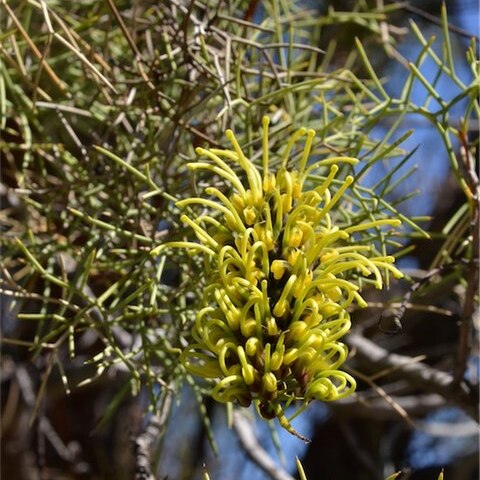Tree or shrub to 6 m high, resprouting from base. Branchlets red, glabrous or sometimes sparsely (rarely densely) pubescent, glabrescent. Leaves compound, sometimes some simple, 7-20 cm long, sparsely pubescent, quickly glabrescent; final segments (1-) 3-13 (-16), 0.3-12 cm long, 0.8-2.3 mm wide, spreading, ±rigid, straight, rarely uncinate; undivided base 2.5-9 cm long. Inflorescence axillary with 65-120 flowers; rachis 5-14 cm long, sparsely or sometimes densely pubescent with white or dirty brown hairs and/or glandular hairs, rarely glabrous, with indumentum similar on pedicel and perianth. Flowers cream to greenish yellow; pedicels 4-10 mm long. Perianth recurved in mature bud, 5.5-9 mm long. Pistil 21-26 mm long; style ±straight to slightly recurved; pollen presenter almost lateral. Fruit 2.3-4 cm long, glabrous; valves ovate-oblong to ovate, often obliquely so, 0.8-1.4 cm wide; red-brown wood zone 0.5-7.5 mm wide; pale wood zone 3.5-6 (-7) mm wide; beak long, often curved. Seed occupying most of valve, 19-32 cm long, 7-11 mm wide; wing decurrent up to halfway down one side only.
More
A small gnarled tree. It is like Hakea lorea but has shorter, forked leaves. It grows 6-10 m tall and spreads 3-5 m wide. The crown is open and sparse. The trunk is crooked. The bark is grey and deeply cracked. The small branches are red and smooth. The leaves are 7-20 cm long by 0.2 cm wide. They can be simple but are often divided into up to 16 stiff segments. These are 9 cm long. The flowering racemes are 5-14 cm long. They occur in the axils of leaves and are made up of 65-120 flowers. The flowers are yellow. The fruit is 2.3-4 cm long by 1-1.4 cm wide. It has a long curved beak.


